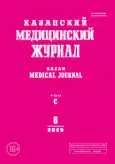Определение состояния канальцевого эпителия почек у маловесных новорождённых с ишемической нефропатией
- Авторы: Ахундова А.А.1
-
Учреждения:
- Азербайджанский медицинский университет
- Выпуск: Том 100, № 6 (2019)
- Страницы: 877-884
- Тип: Теоретическая и клиническая медицина
- URL: https://ogarev-online.ru/kazanmedj/article/view/17954
- DOI: https://doi.org/10.17816/KMJ2019-877
- ID: 17954
Цитировать
Полный текст
Аннотация
Цель. Изучение диагностической значимости молекул KIM-1 и NGAL в моче и цистатина С в плазме крови у маловесных новорождённых с ишемической нефропатией.
Методы. 150 новорождённых были разделены на три группы: основная группа — 72 маловесных новорождённых с проявлениями ишемической нефропатии разделены на три подгруппы: 1А — 1-й степени тяжести (n=36), 1Б — 2-й степени тяжести (n=20), 1В — 3-й степени тяжести (n=16); группа сравнения — 28 маловесных детей без проявлений ишемической нефропатии; контрольная группа — 50 здоровых новорождённых (20 доношенных и 30 недоношенных). Для оценки состояния канальцевого эпителия почек определяли в моче новорождённых уровень молекул KIM-1 и NGAL, для определения состояния клубочковой фильтрации — содержание цистатина С в плазме крови. Пробы мочи и крови были собраны двукратно в 1–3-й и 7–10-й дни жизни. Уровни биомаркёров определяли методом твердофазного иммуноферментного анализа.
Результаты. В основной группе на 1–3-й день жизни концентрации KIM-1 и NGAL в моче были достоверно повышены по отношению к контролю (p <0,001). На 7–10-й день уровень KIM-1 в моче в подгруппе 1А снизился (0,98±0,09 нг/дл), оставаясь высоким по отношению к контролю, а в подгруппах 1Б и 1В повысился и составил 1,24±0,10 и 1,36±0,12 нг/дл соответственно. На 7–10-й день жизни содержание молекул NGAL в моче у детей всех трёх подгрупп снизилось, оставаясь высоким по сравнению с контрольными значениями. Концентрация цистатина С на 1–3-и сутки была достоверно повышена только подгруппе 1В (p <0,01).
Вывод. Молекулы NGAL и KIM-1 служат ранними маркёрами ишемического повреждения почек у маловесных новорождённых, перенёсших перинатальную гипоксию, а цистатин C нельзя считать ранним предиктором поражения почек у маловесных новорождённых с ишемической нефропатией, так как его уровень в крови повышается только при тяжёлой стадии повреждения.
Ключевые слова
Полный текст
Открыть статью на сайте журналаОб авторах
Афаг Ариф гызы Ахундова
Азербайджанский медицинский университет
Автор, ответственный за переписку.
Email: nauchnayastatya@yandex.ru
Азербайджан, г. Баку, Азербайджан
Список литературы
- Moore M.L. Preterm birth: A continuing challenge. J. Perinat. Educ. 2002; 11 (4): 37–40. doi: 10.1624/105812402X88948.
- Drukker A., Guignard J.P. Renal aspects of the term and preterm infant. Curr. Opin. Pediatr. 2002; 14 (2): 175–182. doi: 10.1097/00008480-200204000-00006.
- Куликова Н.Ю., Чаша Т.В., Можаева А.Н., Кузьменко Г.Н. Ишемическая нефропатия у новорождённых, клинико-лабораторная характеристика, прогнозирование и ранняя диагностика. Здоровье ребёнка. 2010; (2): 104–107.
- Bonventre J.V. Kidney injury molecule-1 (KIМ-1): a urinary biomarker and much more. Nephrol. Dial. Transplant. 2009; (24): 3265–3268. doi: 10.1093/ndt/gfp010.
- Haase M., Bellomo R., Devarajan P. et al. Accuracy of neutrophil gelatinase-associated lipocalin (NGAL) in diagnosis and prognosis in acute kidney injury: a systematic review and meta-analysis. Am. J. Kidney Dis. 2009; 54 (6): 1012–1024. doi: 10.1053/j.ajkd.2009.07.020.
- Li Y., Fu C., Zhou X. et al. Urine interleukin-18 and cystatin-C as biomarkers of acute kidney injury in critically ill neonates. Pediatr. Nephrol. 2012; 27 (5): 851–860. doi: 10.1007/s00467-011-2072-x.
- Oncel M.Y., Canpolat F.E., Arayici S. et al. Urinary markers of acute kidney injury in newnorns with perinatal asphyxia. J. Renal Fail. 2016; 38: 882–888. doi: 10.3109/0886022X.2016.1165070.
- Sarafidis K., Tsepkentzi E., Agakidou E. et al. Serum and urine acute kidney injury biomarkers in asphyxiated neonates. Pediatr. Nephrol. 2012; 27 (9): 1575–1582. doi: 10.1007/s00467-012-2162-4.
- Lu H., Fan Q., Wang L. et al. Urinary NGAL and KIM-1 are the early detecting biomarkers of preterm infants with acute kidney injury. Yangtze Med. 2019; 3: 183–194. doi: 10.4236/ym.2019.33019.
- El-Gammasy T.M., Shinkar D.M., Mohamed N.R., Al-Halag A.R. Serum cystatine C as an early predictor of acute kidney injury in preterm neonates with respiratory distress syndrome. Scand. J. Clin. Lab. Invest. 2018; 78 (5): 352–357. doi: 10.1080/00365513.2018.1472803.
- El-Gamasy M.A. Early predictor of acute kidney injury in a sample of Egyptian full term neonates. Med. Clin. Rev. 2017; 3 (12): 1–5.
- Зеленцова В.Л., Шилко В.И., Медведева С.Ю. Морфологические особенности почек у плодов и новорождённых, перенёсших гипоксию. Арх. патол. 2003; 65 (6): 40–44.
- Панахова Н.Ф., Гасанов С.Ш., Ахундова А.А. и др. Функциональная характеристика почек недоношенных новорождённых, родившихся у матерей с преэклампсией. Рос. вестн. перинатол. и педиатрии. 2014; 59 (3): 57–62.
Дополнительные файлы






